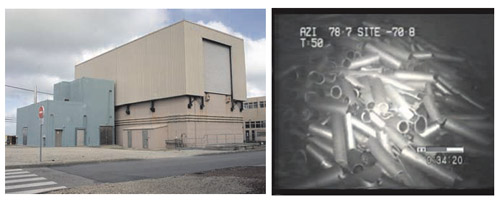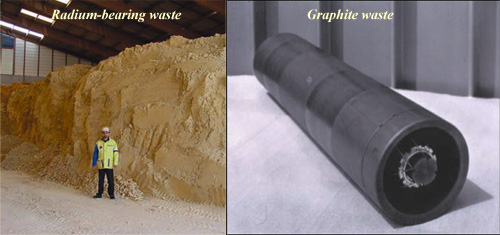Low-level long-lived waste (LLW-LL)

Storage in silos
Graphite ‘sleeves’ used to surround the fuel elements in the old type of French reactor, the gas-cooled, graphite-moderated reactor (GCR). The reactors of this type were decommissioned some years ago. The sleeves are stored (right) in a silo and a bunker. You can see (left) one of these silos, silo 115, containing 3 ventilated steel tanks of 400 m3 where production from 1966 to 1974 is stored
© ANDRA (Source ANDRA Catalogue)
Low-level waste, which has a much lower level of activity than high-level and intermediate-level waste (HLW and ILW-LL), is in a category of its own. It is not covered by the research being done under the Bataille Act in France, but its future management is the subject of study. Because it contains mainly long-lived radioelements, it cannot be sent to disposal facilities for short-lived or very low-level waste.
The main waste in this category is radium-bearing waste and graphite waste.
Radium-bearing waste comes mainly from the use of weakly radioactive ores containing what are known in chemistry as rare earths, and yttrium. They are used most notably in the manufacture of audio and video products and catalytic converters for cars. They contain a significant amount of radium-226 or thorium-232 (long-lived elements). Industrial processing has the effect of concentrating the natural radioactivity in the residues. Certain luminous paints, items like lightning rod heads, and some of the waste from cleaning up contaminated sites are also radium-bearing waste.
The radioactivity of radium-bearing waste is generally between a few tens of Bq and several thousand Bq per gram. The radioactive atoms are mainly long-lived alpha
and several thousand Bq per gram. The radioactive atoms are mainly long-lived alpha -emitters.
-emitters.
For radium-bearing waste, ANDRA’s research has confirmed that subsurface disposal is a suitable solution. The technique would consist of digging waste disposal cells in clay at a depth of 15 metres. Thee cells would then be covered over again with the same clay.
Radium-bearing waste is stored as it is, pending the opening of a dedicated disposal facility. Treatment and the definition of appropriate conditioning may therefore be required before it can be put into a disposal facility. Producers of this waste are currently looking into a conditioning method in the form of a concrete waste package.

Radium-bearing waste and graphite waste
Long-lived low-level waste are of several types. Radium-bearing waste is linked to the use of radium in the 1920s and to industries extracting rare earth ores. Graphite waste comes from the dismantling of first-generation graphite-gas reactors that have been shut down. In addition to this inventory, there is miscellaneous waste such as used radioactive sources and old objects containing radium.
© ANDRA
Graphite waste comes from the old graphite-moderated, gas-cooled reactors that used natural uranium, which have now been decommissioned. The graphite, which was used for slowing down the neutrons, had to be very pure. A distinction has to be made between the graphite ‘sleeves‘, in which the fuel was placed, and the graphite ‘stacks‘holding it all together. The radioactivity of this graphite waste is generally between ten and a hundred KBq per gram. The radioactive atoms are mainly long-lived beta
per gram. The radioactive atoms are mainly long-lived beta -emitters: carbon-14 but also chlorine-36 from impurities in the graphite.
-emitters: carbon-14 but also chlorine-36 from impurities in the graphite.
The results of the research on graphite waste are expected in 2014. The least active waste could be disposed of in subsurface facilities and the most active in a special disposal repository at a depth of 100 m. The most active waste (the sleeves) could also be disposed of at the CIGEO disposal facility, which is being prepared for high-level and intermediate-level waste, some of it long-lived.
Definitive management solutions are still awaited for low-level long-lived waste (LLW-LL). This waste is currently stored at various facilities such as Cadarache, and the CEDRA radioactive waste storage centre.
No decision has been made on the siting of this facility to date. Locations for these disposal facilities will have to be found. An initial call for applications from municipalities was launched by ANDRA in 2008. Two municipalities that gave a positive response to this call for applications withdrew from the process in 2009. ANDRA therefore reviewed the whole project and submitted new proposals to the government in 2012.
Learn more :
Waste panorama
Various radioactive waste
Radium-bearing waste
ANDRA web site (international)
Other articles on the subject « Waste Classification »
High-level waste (HLW)
Spent nuclear fuels and vitrified waste High-level waste is waste for which management is a prior[...]
Intermediate-level waste (ILW-LL)
Intermediate-level long-lived waste (ILW-LL) The French classification system uses ILW-LL to refe[...]
Low and intermediate-level waste
Low- and intermediate-level short-lived waste (LILW-SL) In France, the oldest disposal facility f[...]
Very low-level waste (VLLW)
VLLW: very low-level waste VLLW: the least radioactive category Very low-level waste (VLLW) sits [...]